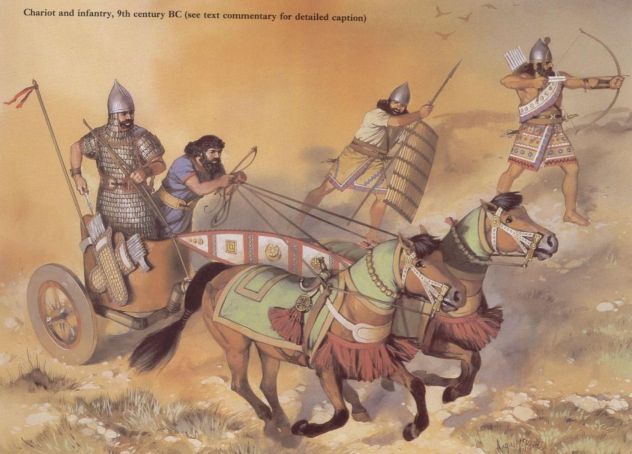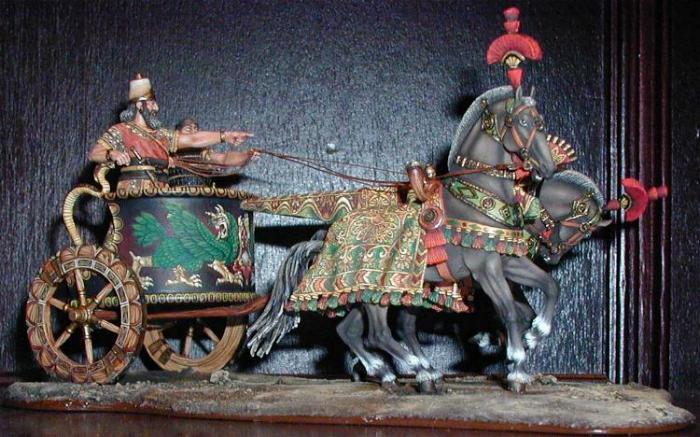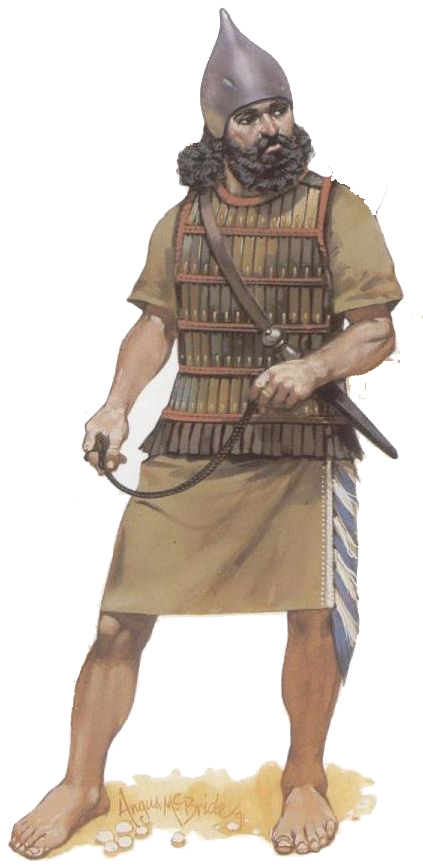Sumerian images (if that's what's decided):
The Sumerians invented the chariot, which they harnessed to onagers. These early chariots functioned less effectively in combat than did later designs, and some have suggested that chariots served primarily as transports, though the crew carried battle-axes and lances. The Sumerian chariot comprised a four-wheeled device manned by a crew of two and harnessed to four onagers. The carriage was composed of a woven basket and the wheels had a solid three-piece design.
Light infantrymen carried battle-axes, daggers, and spears. The regular infantry also used copper helmets, felt cloaks, and leather kilts.
Source
Summary: four solid wheels, funny windshield at the front of the carriage, pulled by donkeys (make 'em smaller than horses, grey and with long ears!

). The passengers should at least wear those funky motorcycle-style helmets and carry lances (for poking, not throwing?). Too bad we can't have them hacking with those socket-style axes!
 Intermediate image
Intermediate image:
(This isn't listed as an Assyrian chariot but one from Ur, but I'm guessing it will be closer to what Louis wants for the Assyrian chariot -- minus the solid wheels. This was the closest thing to a schematic drawing that I could find.)
Assyrian images:
This is a
very early Assyrian chariot (9th Century B.C.), so I dunno if it's what Louis has in mind. Apparently the armament of the soldiers (guys on foot and the dude in the chariot) are more Mittanni-influenced than the classical Lamellar Armoured Assyrian soldiers we all know and fear. Apparently the fabric horse armour was already around at this time (wouldn't those horses die of heat exhaustion wearing that kind of outfit in the Middle-East?) Notice how clearly the cool-shaped and coloured "drive shaft" (???) is depicted here. Maybe this chariot would be fine so long as the guys inside it weren't draped in silvery scale armour?
The chariots of the Egyptians and Assyrians, with whom the bow was the principle arm of attack, were richly mounted with quivers full of arrows, while those of the Greeks, whose characteristic weapon was the spear, were plain except as regards mere decoration.
Source
Top-down view of two
light Assyrian chariots (I believe this is closer to what Louis wants):
Now for some
heavy Assyrian chariots one of which I posted a picture of, above.
Unfortunately, most of the Assyrian chariot pics I can find are of
royal chariots (I think that's what you found, riptide), and I imagine that's not quite what the regular military charioteer would be in!
(Damn, that's a big picture!) One thing about Assyrian Royal Chariots is that they had a parasol. Nobody else had parasols, as this was a symbol of royalty. So don't put a parasol on the chariot unless we are s'posed to use it as a king unit!

Summary: big-ass spoked wheels, large semi-circular carriage (probably a lot like the Etruscan-Trojan-Mycenean chariots, but maybe larger???), uniquely shaped "drive shaft," crazy paint jobs, green (apparently) fabric armour on the horses, no parasol, and passengers inside wearing lamellar armour firing a composite bow -- at least (no need for the sheild bearers, if I get Louis' intentions correct).
Here's a picture of a classical Assyrian soldier wearing an iron helmet and bronze lamellar armour (he's a slinger, so I think he gets the corslet because he can't hold a shield?):
And I was right, no schematic drawings!

I'll see what I can ruslte-up for war wagons, now...


























